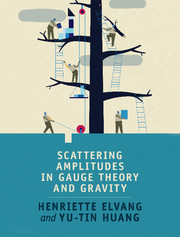1 - Introduction
Published online by Cambridge University Press: 05 January 2015
Summary
Scattering experiments are crucial for our understanding of the building blocks of nature. The standard model of particle physics was developed from scattering experiments, including the discovery of the weak force bosons W± and Z0, quarks and gluons, and most recently the Higgs boson.
The key observable measured in particle scattering experiments is the scattering crosssection σ. It encodes the likelihood of a given process to take place as a function of the energy and momentum of the particles involved. A more refined version of this quantity is the differential cross-sectiondσ/ dΩ: it describes the dependence of the cross-section on the angles of the scattered particles.
Interpretation of data from scattering experiments relies heavily on theoretical predictions of scattering cross-sections. These are calculated in relativistic quantum field theory (QFT), which is the mathematical language for describing elementary particles and their interactions. Relativistic QFT combines special relativity with quantum physics and is a hugely successful and experimentally well-tested framework for describing elementary particles and the fundamental forces of nature. In quantum mechanics, the probability distribution |ψ|2 = ψ * ψ for a particle is given by the norm-squared of its complex-valued wavefunction ψ. Analogously, in quantum field theory, the differential cross-section is proportional to the norm-squared of the scattering amplitudeA, dσ/ dΩ ∝ |A|2. The amplitudes A are well-defined physical observables: they are the subject of this book.
Scattering amplitudes have physical relevance through their role in the scattering cross-section. Moreover, it has been realized in recent years that amplitudes themselves have a very interesting mathematical structure. Understanding this structure guides us towards more efficient methods to calculate amplitudes. It also makes it exciting to study scattering amplitudes in their own right and explore (and exploit) their connections to interesting branches of mathematics, including combinatorics and geometry.
- Type
- Chapter
- Information
- Scattering Amplitudes in Gauge Theory and Gravity , pp. 1 - 12Publisher: Cambridge University PressPrint publication year: 2015

